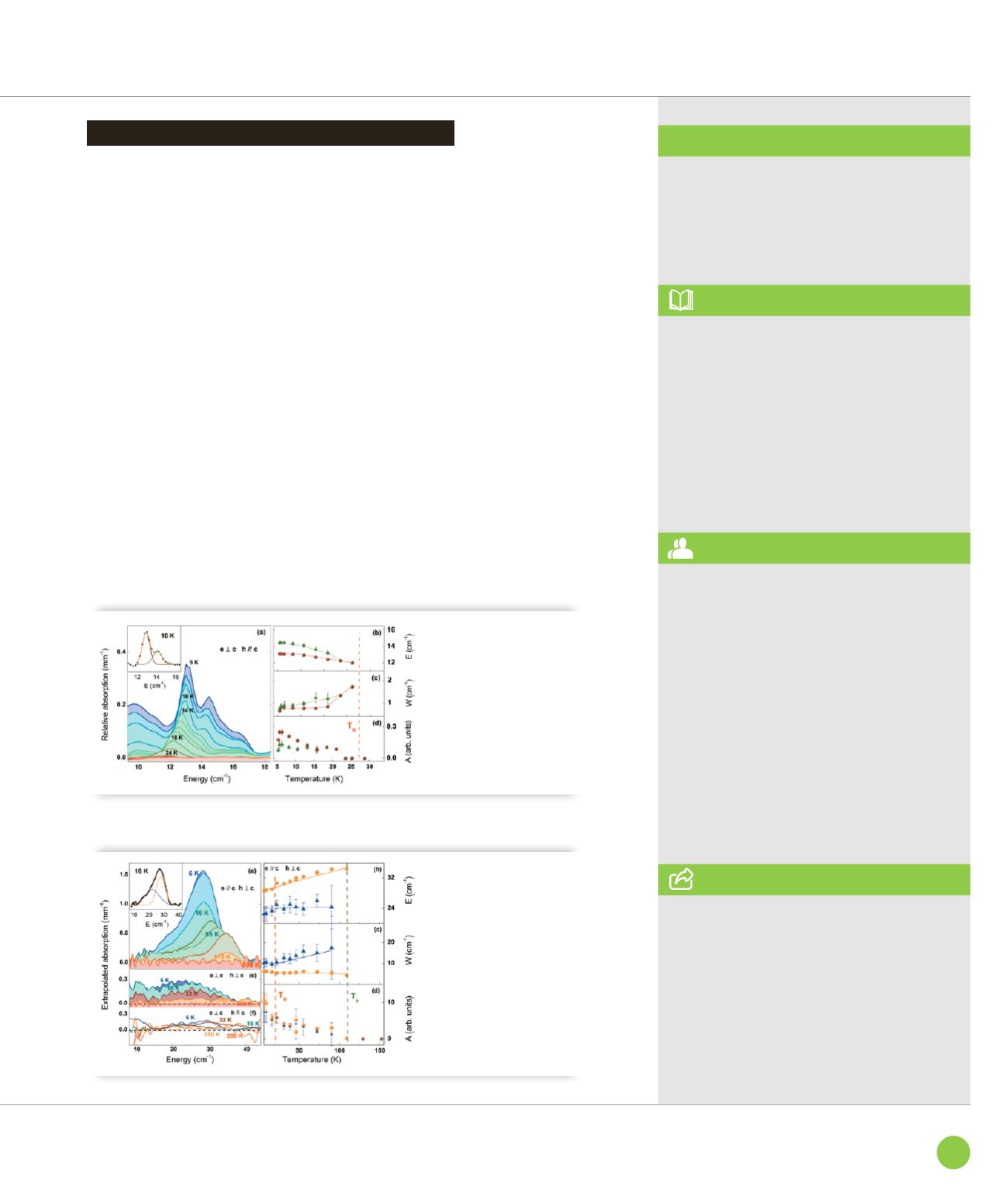
THz spectra have been measured in the
temperature range 6K - 200 K (Figure
➋
-
➌
). Around 13 cm
-1
magnons are present
at low temperatures and disappear
when approaching T
N
. These magnetic
excitations are in agreement with the
neutron inelastic measurements and spin
wave calculations on this compound [5].
More surprisingly, other broader
excitations are observed, centered
at 23cm
-1
(E1) and 29 cm
-1
(E2) at low
temperatures that disappear only above
T
P
≈100 K. Using different THz polarization,
we have determined that E1 is magneto
active with h
⊥
c, while E2 is electric active
with e//c. Both excitations cannot be
associated to the magnetic order since
they persist up to T
P
which is almost
4 times T
N
; they are also absent in the
spin wave neutron measurements at the
equivalent zone center. These excitations
are more likely related to the lattice. Based
on symmetry analysis in the P321 space
group, we propose a model depicted in
Figure
➊
. We suggest that there exists
a lattice excitation (E2) associated to
atomic rotations around the c-axis that can
be excited by e//c similarly to conventional
optical phonons. Its magneto active
counterpart E1 is more subtle: it required
a static polarization P
⊥
perpendicular
to the c-axis. The shift in energy between
E1 and E2 reflects the dispersion curve
of these excitations: while E1 is excited
at q=0 as for an optical phonon seen
in optical spectroscopy, E2 is excited
for a wave vector Q corresponding
to the periodicity of P
⊥
along the c-axis.
We have then foreseen the existence,
below T
P
, of a polar helicoidal state.
It is formed by an helical arrangement
of electric dipoles which, due to the
chirality of the compound, must itself
have a definite sense of rotation.
Our findings widen the type of magneto-
electric excitations that could be used
for magnonics applications.
Magnetic and magneto-electric properties
AILES beamline
ASSOCIATED PUBLICATION
THz magnetoelectric atomic rotations
in the chiral compound Ba
3
NbFe
3
Si
2
O
14
L. Chaix, S. de Brion*, F. Lévy-Bertrand,
V. Simonet, R. Ballou, B. Canals, P. Lejay,
J.B. Brubach, G. Creff, F. Willaert, P. Roy
and A. Cano
Physical Review Letters 110 (2013) 157208
* Institut Néel, CNRS - Université Joseph
Fourier, BP166, 38042 Grenoble Cedex 9,
France
CORRESPONDING AUTHOR
➋
THz excitations probed with
a 125 µm beam splitter. (
a
)
Absorption spectra relative
to the one at 45K. Insert:
Gaussian fits. (
b
) (
c
) (
d
)
temperature dependence of
the fits position, width and
area.
➌
THz excitations probed
with the 6 µm beam splitter.
(
a
) Absorption spectra
obtained for e//c and h
⊥
c.
Insert: Gaussian fits. (
b
) (
c
)
(
d
) Temperature dependence
of the fits position, width and
area. (
e
) (
f
) Same as (
a
) for
the other THz polarizations.
REFERENCES
[1] N.A. Spaldin & M. Fiebig, Science 309
(2005), 391
[2] A. Pimenov et al. Nat. Phys. 2 (2006), 97
[3] R. D. Johnson et al. Phys. Rev. Lett. 108
(2012), 067201
[4] K. Marty et al. Phys. Rev. Lett. 101 (2008),
247201
[5] M. Loire et al. Phys. Rev. Lett. 106 (2011),
207201
101
SOLEIL
HIGHLIGHTS
2013


